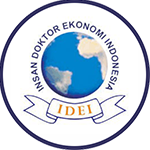AI Competence’s Impact on Innovation in The Creative Industries: Moderating Role of Individual Creativity
Downloads
This research aims to investigate the relationship between Artificial Intelligence (AI) competence and innovation, as well as the moderating effect of creativity in the context of Indonesian creative industries. The objectives are accomplished by conducting surveys and analyzing the data using a quantitative approach. The samples are people who are working in various sectors of the creative industries in Indonesia, with a minimum age of 18. The data was collected by using a non-probability, convenience sampling method. 268 completed questionnaires were collected from the eligible samples. The results of hypothesis testing using PLS-SEM indicate that AI competence has a significantly positive impact on innovation. While individual creativity moderates the relationship between AI competence and innovation. Intriguingly, this moderating effect goes in the negative direction. For the theoretical implication, the effect of creativity in enhancing competence, especially in using new technology, should be studied further by more rigorous research. In addition, this research suggests that the creative industries stakeholders should provide sufficient training for creative workers, allowing them to develop their competence in using AI programs related to their job or tasks.
Alvarez, R. (2016). The impact of R&D and ICT Investment on Innovation and Productivity in Chilean
Firms. IDB Publication. https://doi.org/https://doi.org/10.18235/0009293
Alvi, M. (2016). A Manual for Selecting Sampling Techniques in Research, Mohsin Hassan Alvi. 70218.
Amabile, T. M. (1996). Creativity and Innovation in Organizations.
Astuty, E., Rahayu, A., Disman, & Wibowo, L. A. (2018). Breakthrough in the Indonesian creative industry
through soft innovation. Journal of Legal, Ethical and Regulatory Issues, 22(2).
Ausat, A. M. A., Al Bana, T., & Silvy Sondari Gadzali. (2023). Basic Capital of Creative Economy: The
Role of Intellectual, Social, Cultural, and Institutional Capital. Apollo: Journal of Tourism and
Business, 1(2), 42–54. https://doi.org/10.58905/apollo.v1i2.21
Azmat, F., Lim, W. M., Moyeen, A., Voola, R., & Gupta, G. (2023). Convergence of business, innovation,
and sustainability at the tipping point of the sustainable development goals. Journal of Business
Research, 167(July), 114170. https://doi.org/10.1016/j.jbusres.2023.114170
Bigliardi, B., Ferraro, G., Filippelli, S., & Galati, F. (2020). The Influence of Open Innovation on Firm
Performance. International Journal of Engineering Business Management, 12.
Calik, E., Calisir, F., & Cetinguc, B. (2017). A Scale Development for Innovation Capability Measurement.
Journal of Advanced Management Science, 5(2), 69–76. https://doi.org/10.18178/joams.5.2.69-76
Caniëls, M. C. J., & Rietzschel, E. F. (2015). Organizing creativity: Creativity and innovation under
constraints. Creativity and Innovation Management, 24(2), 184–196.
https://doi.org/10.1111/caim.12123
Castillo-Vergara, M., & García-Pérez-de-Lema, D. (2021). Product innovation and performance in SME’s:
the role of the creative process and risk taking. Innovation: Organization and Management, 23(4),
–488. https://doi.org/10.1080/14479338.2020.1811097
Corvello, V. (2025). Generative AI and the future of innovation management: A human centered
perspective and an agenda for future research. Journal of Open Innovation: Technology, Market, and
Complexity, 11(1). https://doi.org/10.1016/j.joitmc.2024.100456
Cunningham, S. (2002). From cultural to creative industries: Theory, industry, and policy implications.
Media International Australia Incorporating Culture and
Policy, 102, 54–65.
https://doi.org/https://doi.org/10.1177/1329878X0210200107
Ebert, C., & Hemel, U. (2024). Grow Your Artificial Intelligence Competence. In Computer (Vol. 57, Issue
, pp. 144–150). IEEE Computer Society. https://doi.org/10.1109/MC.2024.3436168
Etikan, I., Musa, S. A., & Alkassim, R. S. (2016). Comparison of Convenience Sampling and Purposive
Sampling. 5(1), 1–4. https://doi.org/10.11648/j.ajtas.20160501.11
Fauziah, K. W. A., Juwiyan, Y. L., Lestari, M. I., Kurniawati, H., & Deviarti, H. (2025). The QRIS Effect:
What Truly Motivates MSMEs to Go Digital? Airlangga Journal of Innovation Management, 6(2),
–302. https://doi.org/10.20473/ajim.v6i2.72231
Ferdiansyah, R. (2025). Analysis of the Influence of Creative Industries on Economic Growth Indonesia
Urban Areas. Journal of Regional Economic Studies, 1(1), 1–12.
Fornell, C. G., & Larcker, D. F. (1981). Evaluating Structural Equation Models with Unobservable
Variables and Measurement Error. Journal of Marketing Research, 18(1).
Füller, J., Hutter, K., Wahl, J., Bilgram, V., & Tekic, Z. (2022). How AI revolutionizes innovation
management – Perceptions and implementation preferences of AI-based innovators. Technological
Forecasting and Social Change, 178(April 2021), 121598. https://doi.org/10.1016/j.techfore.2022.121598
Gaglio, C., Kraemer-Mbula, E., & Lorenz, E. (2022). The effects of digital transformation on innovation
and productivity: Firm-level evidence of South African manufacturing micro and small enterprises.
Technological Forecasting and Social Change, 182(March), 121785.
https://doi.org/10.1016/j.techfore.2022.121785
Hair, J. F., Risher, J. J., Sarstedt, M., & Ringle, C. M. (2019). When to use and how to report the results of
PLS-SEM. In European Business Review (Vol. 31, Issue 1, pp. 2–24). Emerald Group Publishing Ltd.
https://doi.org/10.1108/EBR-11-2018-0203
Hall, B. H., Lotti, F., & Mairesse, J. (2013). Evidence on the impact of R&D and ICT investments on
innovation and productivity in Italian firms. Economics of Innovation and New Technology, 22(3),
–328.
Holmström, J., & Carroll, N. (2024). How organizations can innovate with generative AI. Business
Horizons. https://doi.org/10.1016/j.bushor.2024.02.010
Hughes, A., Lee, D. ;, Jr, A., & Tian, ; (2018). Leadership, creativity, and innovation: A critical review and
practical recommendations. http://hdl.handle.net/10871/32289
Imjai, N., Nui-Suk, C., Usman, B., Somwethee, P., & Aujirapongpan, S. (2024). The influence of AI
competency and design thinking skills on innovative entrepreneurial competency: The role of strategic
intelligence amongst new age entrepreneurs in Thailand. International Journal of Information
Management Data Insights, 4(2). https://doi.org/10.1016/j.jjimei.2024.100301
Istiqamah, V. A., & Zakik. (2024). The Effect of Sharia Financial Inclusion on Creative Industry Financing
(KSPPS BMT-NU Lenteng Branch, Sumenep). Airlangga Journal of Innovation Management, 5(3),
–415. https://doi.org/10.20473/ajim.v5i3.60067
Jones, C., Lorenzen, M., & Sapsed, J. (2015). The oxford handbook of creative industries. Oxford
University.
Kaplan, A., & Haenlein, M. (2019). Siri, Siri, in my hand: Who’s the fairest in the land? On the
interpretations, illustrations, and implications of artificial intelligence. In Business Horizons (Vol. 62,
Issue 1, pp. 15–25). Elsevier Ltd. https://doi.org/10.1016/j.bushor.2018.08.004
Kostromina, H., Potishchuk, O., Rudenko, T., Pushkar, M., & Romaniuk, O. (2023). Intellectual Сapital
As the Basis for the Development of Сreative Industries. IJCSNS International Journal of Computer
Science and Network Security, 23(3), 208–214. https://doi.org/10.22937/IJCSNS.2023.23.3.23
Long, D., & Magerko, B. (2020, April 21). What is AI Literacy? Competencies and Design Considerations.
Conference on Human Factors in Computing Systems - Proceedings. https://doi.org/10.1145/3313831.3376727
Marrone, R., Cropley, D., & Medeiros, K. (2024). How Does Narrow AI Impact Human Creativity? In
Creativity Research Journal. Routledge. https://doi.org/10.1080/10400419.2024.2378264
Miltner, K., & Highfield, T. (n.d.). The Possibilities of “Good” Generative AI in the Cultural and Creative
Industries.
Mohammadabadi, S. M. S. (2025). From Generative AI to Innovative AI: An Evolutionary Roadmap.
http://arxiv.org/abs/2503.11419
Mü, K., Rammer, C., & Trü, J. (n.d.). The Role of Creative Industries in Industrial Innovation.
http://ssrn.com/abstract=1328878Electroniccopyavailableat:https://ssrn.com/abstract=1328878
Müller, K., Rammer, C., & Trü, J. (2008). The Role of Creative Industries in Industrial Innovation. In Dis
cus si on Paper.
Ndesaulwa, A. P., & Kikula, J. (2016). The Impact of Innovation on Performance of Small and Medium
Enterprises (SMEs) in Tanzania: A Review of Empirical Evidence. Journal of Business and
Management Sciences, 4(1), 1–6. https://doi.org/10.12691/jbms-4-1-1
Ouakouak, M. L., & Ouedraogo, N. (2017). Antecedents of Employee Creativity and Organizational
Innovation: An Empirical Study. International Journal of Innovation Management, 21(7).
https://doi.org/https://doi.org/10.1142/S1363919617500608
Parida, V., & Ortqvist, D. (2015). Interactive effects of network capability, ICT capability, and financial
slack on technology-based small firm innovation performance. Journal of Small Business
Management, 53, 278–298.
Piller, F. T., Srour, M., & Marion, T. J. (2024). Generative AI, Innovation, and Trust. Journal of Applied
Behavioral Science. https://doi.org/10.1177/00218863241285033
Prasetiyo, W. G., Mubarok, D. A. A., Sofiati, N. A., Ali, M. M., & Sajekti, T. (2025). Enhancing MSMEs’
Innovation Capacity Based on the ISO 56002:2019: A Case Study of the XYZ Perfume Company in
Yogyakarta. Airlangga Journal of Innovation Management, 6(1), 30–52. https://doi.org/10.20473/ajim.v6i1.70962
Richard, V., Lebeau, J. C., Becker, F., Inglis, E. R., & Tenenbaum, G. (2018). Do more creative people
adapt better? An investigation into the association between creativity and adaptation. Psychology of
Sport and Exercise, 38(September), 80–89. https://doi.org/10.1016/j.psychsport.2018.06.001
Rozikin, R., & Tasrif, M. J. (2023). Potensi Ekonomi Kreatif Tahun 2024 Negara Indonesia. Jurnal
Manajemen FE-UB, 11(2).
Sajja, P. S. (2021). Introduction to artificial intelligence. Illustrated Compuational Intelligence, Examples
and Applications, 1–25.
Sedkaoui, S., & Benaichouba, R. (2024). Generative AI as s transformative force for innovation: A review
of opportunities, applications and challenges. European Journal of Innovation Management.
Song, Y., Chen, G., & Zhang, Y. (2019). HRM Strategies for Enhancing Competitiveness of Culture
Creative Industry: Based on Literature Reviews. 2019 5th International Conference on Humanities
and Social Science Research.
Vivarelli, M. (2007). Innovation and Employment: A Survey. IZA Discussion Paper.
Wang, B., Rau, P. L. P., & Yuan, T. (2023). Measuring user competence in using artificial intelligence:
validity and reliability of artificial intelligence literacy scale. Behavior and Information Technology,
(9), 1324–1337. https://doi.org/10.1080/0144929X.2022.2072768
Zhang, X., & Bartol, K. M. (2010). LINKING EMPOWERING LEADERSHIP AND EMPLOYEE
CREATIVITY: THE INFLUENCE OF PSYCHOLOGICAL EMPOWERMENT, INTRINSIC
MOTIVATION, AND CREATIVE PROCESS ENGAGEMENT. In Source: The Academy of
Management Journal (Vol. 53, Issue 1). https://about.jstor.org/terms
Copyright (c) 2025 Airlangga Journal of Innovation Management

This work is licensed under a Creative Commons Attribution-NonCommercial-ShareAlike 4.0 International License.
- The journal allows authors to hold copyright without restrictions and retain publication rights without restrictions. The author retains the copyright and grants the first publication rights to the journal, with his work simultaneously licensed under the Creative Commons Attribution-NonCommercial-ShareAlike 4.0 International License (CC BY-NC-SA). This license allows others to share the work with acknowledgment of authorship and initial publication in this journal, provided that the work is not used for commercial purposes and that any derivative works must use the same license.
- Authors may enter into additional contractual agreements for non-exclusive distribution of the journal publication version (e.g., uploading it to an institutional repository or publishing it in book form), while still including acknowledgment of the initial publication in this journal.
- Authors are allowed and encouraged to upload their work online (e.g., in an institutional repository or personal website) before and during the submission process. This can support productive scientific exchanges as well as increase citations to published works.

AJIM by UNAIR is licensed under a Creative Commons Attribution-NonCommercial-ShareAlike 4.0 International License.





















